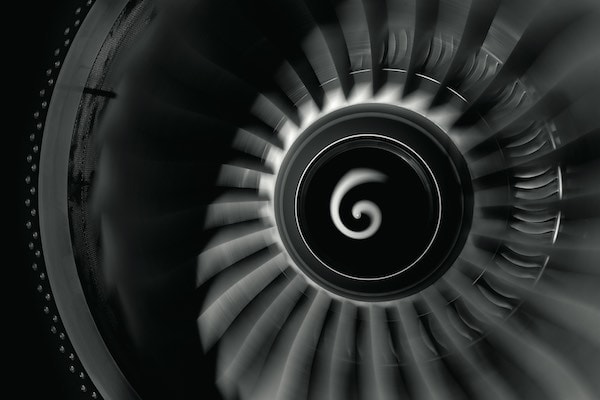
[Image above] Credit: SuperJet International; Flickr CC BY-SA 2.0
It isn’t easy to develop new materials for demanding applications.
Which is why the August issue of Nature Materials focuses on the search for new materials for one of the most demanding applications out there—aerospace.
The issue hones in on key challenges in the aerospace industry, highlighting high-temperature materials for gas turbine engines and identifying remaining barriers that prevent adoption of new material-based technologies.
The issue’s opening editorial captures the challenges of designing aerospace materials: “Developing materials for jet engines is extremely tricky. High temperatures open up a sizeable palette of structure-altering phenomena, exacerbated by substantial mechanical loads. The intricacy of the problem is further amplified by complex load regimes during the course of a flight, and by the rotation of turbine components. Resistance to chemical attack is also important.”
Read: it ain’t easy.
Yet that doesn’t dissuade ACerS member and Fellow Nitin Padture—engineering professor, director of the Institute for Molecular and Nanoscale Innovation, and Otis E. Randall University Professor (designate) at Brown University (Providence, R.I.).
Padture’s lab studies ceramic composites and coatings for aerospace applications, in addition to many other areas of materials research, including how to improve the stability of perovskite solar cells and the merits of 2-D material superstar graphene.
Padture penned one of three commentaries for the aerospace-centered issue of Nature Materials. Padture’s article, “Advanced structural ceramics in aerospace propulsion,” details the vital role of advanced structural ceramics in ever-advancing vehicle propulsion systems.
Padture’s commentary discusses thermal barrier coatings for superalloys, ceramic matrix composites as superalloy replacements, and thermal and environmental barrier coatings for ceramic matrix composites—all of which are major areas of active research into aerospace materials.
Although thermal barrier coatings have drastically increased maximum temperatures in the hottest parts of gas-turbine engines—increasing efficiency and performance and cleaning up exhaust—these thin ceramic layers are not without limitations, Padture writes in the article.
As temperature demands continue to rise, the go-to thermal barrier coating material 7YSZ is starting to fall short. So the aerospace industry needs new materials with lower thermal conductivities and better resistance to environmental challenges like volcanic ash—and these needs are catalyzing the search for alternative materials.
But, as aforementioned, finding the perfect new material is no simple task. So current efforts are instead looking to multilayer or multiphase coatings to achieve what a single material cannot on its own.
Although research on thermal barrier coatings are pushing these materials to withstand hotter temperatures, however, the superalloy materials that barrier coatings protect haven’t had the same luxury.
Padture writes, “As a consequence, the temperature-capability gap between TBCs and superalloys is widening. This necessitates more aggressive cooling to allow higher gas temperatures, but without a commensurate increase in the specific engine power that results in rising inefficiency losses. The only way to address this issue is to use materials with inherently higher temperature capabilities.”
And when it comes to higher temperature capabilities, ceramics definitely have the upper hand.
The integration of ceramic matrix composites in commercial jet engines this year demonstrates just a small fraction of the potential these materials hold for revolutionizing the aerospace industry.
Despite their awesome properties, however, one significant problem with CMCs is figuring out how to join them to other materials. Here Padture taps into the potential of integrated ceramic textile structures (ICTS), a new paradigm that uses computationally designed preforms to meet component needs.
A mesh of textiles, math, ceramics, and mechanics, ICTS uses computational design to build components based on specific required parameters, while taking into account physical properties and materials knowledge. By employing a ‘smart’ design of material components, ICTS can develop hollow and thin preforms that translate into stronger and lighter parts by reducing porosity.
“ICTSs are in their infancy, but the prospect of lightweight, thin-walled components that can outperform their metallic and 2-D CMC counterparts, while requiring less cooling, is indeed enticing,” Padture writes.
So how does one design entirely new materials to withstand these incredibly demanding environments?
The research community needs experimentally validated models to be able to predict how newly designed materials—such as multilayered and multiphase materials—will behave in realistic engine conditions, Padture writes. Modeling, and subsequent experimental validation, will guide materials discovery through the unique challenges posed by aerospace applications.
But, even with the incredible challenges, Padture is optimistic about how advanced ceramics fit into the equation.
“Materials remain the bottleneck in realizing many of our aerospace aspirations, but this also presents a fountainhead of opportunities for materials discovery, and for innovations in design and manufacturing. In fulfilling those aspirations, advanced structural ceramics will undoubtedly play a crucial role.”
The open-access commentary article, published in Nature Materials, is “Advanced structural ceramics in aerospace propulsion.”
Author
April Gocha
Related Posts
Other materials stories that may be of interest for December 17, 2025
December 17, 2025
Celebrating the US Semiquincentennial: Ohio Creativity Trail
December 16, 2025


